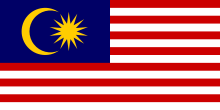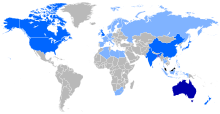| Parts of this article (those related to the statistics for Population and Culture section) need to be updated. Please help update this article to reflect recent events or newly available information. (August 2020) |
| Orang Malaysia (Malay) أورڠ مليسيا (Jawi) 马来西亚人/馬来西亞人 Mǎláixīyà Rén (Chinese) மலேசியர் Malēciyarkaḷ (Tamil) | |
|---|---|
 Flag of Malaysia Flag of Malaysia | |
 Map of the Malaysian diaspora around the world Map of the Malaysian diaspora around the world | |
| Total population | |
| c. 34–35 million (Malaysian diaspora 1,730,152) | |
| Regions with significant populations | |
| Malaysia 35,031,000 (2017 est.) (excluding the diaspora) | |
| Christmas Island Minority populations | More than 981 |
| Singapore | 952,261 |
| Australia | 174,136 |
| United Kingdom | 84,638 |
| United States | 77,647 |
| Brunei | 52,001 |
| China | 26,248 |
| Canada | 25,337 |
| Japan | 18,821 |
| New Zealand | 8,661 |
| India | 12,228 |
| Libya | 8,404 |
| Germany | 5,676 |
| Ireland | 4,595 |
| Netherlands | 4,036 |
| Brazil | 2,608 |
| Indonesia | 2,363 |
| Languages | |
| Malay, English, Mandarin (along with other Chinese languages), Indian languages Malayic • North Bornean • Melanau-Kajang • Aslian • Land Dayak • Sama–Bajaw • Philippine | |
| Religion | |
| Predominantly Minority
| |
| Related ethnic groups | |
| Indonesians | |
Malaysians (Malay: Orang Malaysia; Jawi: أورڠ مليسيا) are citizens who are identified with the country of Malaysia. Although citizens make up the majority of Malaysians, non-citizen residents may also claim a Malaysian identity.
The country is home to people of various national, ethnic and religious origins. As a result, many Malaysians do not equate their nationality with ethnicity, but with citizenship and allegiance to Malaysia. Majority of the population, however, belong to several clearly defined racial groups within the country with their own distinct cultures and traditions: Malays, Orang Asli (aboriginal population), Malaysian Chinese (primarily Han Chinese and Peranakans), Malaysian Indians (primarily South Asian Tamils and Chitty). The majority of the non-Malay and non-aboriginal population in modern Malaysia is made up of immigrants and their descendants. Following the initial period of Portuguese, Dutch and then significantly longer British colonisation, different waves (or peaks) of immigration and settlement of non-indigenous peoples took place over the course of nearly five centuries and continue today.
Malayan independence from the United Kingdom in 1957 grew gradually over the course of latter part of the 20th century since the formation of the Federation of Malaya in 1948 (excluding Crown Colony of Singapore, Crown Colony of North Borneo and Crown Colony of Sarawak). World War II in particular gave rise to a desire amongst Malayans to have their country recognised as a fully-fledged sovereign state with a distinct citizenship.
Population
Main article: Demographics of Malaysia See also: Immigration to MalaysiaAs of 2010, Malaysians make up 0.4% of the world's total population, having relied upon immigration for population growth and social development. Approximately 30% of current Malaysians are first- or second-generation immigrants, and 20 percent of Malaysian residents in the 2000s were not born in Malaysian soil. It is estimated, by 2031, nearly one-half of Malaysians above the age of 15 will be foreign born or have one foreign born parent. Bumiputera, according to the 2010 Malaysian Census, numbered at 17,523,508 or 61.85% of the country's 28,334,135 population.
Citizenship and diaspora
Main articles: Malaysian nationality law and Malaysian diasporaThe Malaysian diaspora has a population of 1,730,152 in 2019, according to the United Nations Department of Economic and Social Affairs. Malaysia does not keep track of emigration and counts of Malaysians abroad are thus only available courtesy of statistics kept by the destination countries. The diaspora includes both descendants of early emigrants from Malaysia, as well as more recent emigrants from Malaysia.
Since independence, a total of 688,766 naturalised foreigners had been granted Malaysian citizenship while 10,828 individuals had their citizenships revoked. The community of Malaysians in Australian external territory of Christmas Island makes up the majority of the population, while Singapore has the largest minority community of Malaysians, with 952,261 people, followed by Australia, the United Kingdom and the United States.
Ethnic groups and citizenship
Main article: Ethnic origins of people in MalaysiaClassification of 2010 Census ethnic group is as set by Inter-Agency Technical Committee (IATC) in Appendix 1. IATC is a committee formed to co-ordinate and monitor the implementation and use of standardised codes, classifications and definitions used by the Department of Statistics, Malaysia and other government agencies. For the purpose of tabulation and analysis, as well as taking into account the diverse ethnic group in Peninsular Malaysia, Sabah, Federal Territory of Labuan and Sarawak, major ethnic groups according to region as follows:
| Peninsular Malaysia | Sabah and Federal Territory of Labuan |
Sarawak |
|---|---|---|
| Malaysian Citizens | ||
| Bumiputera |
Bumiputera Malay |
Bumiputera |
|
Other Bumiputera
| ||
|
Other Malays / Anak Dagang
| ||
|
Non-Bumiputera
Others
| ||
| Non-Malaysian Citizens (including Permanent Residents) | ||
| ||
Information collected in the census including ethnic group and citizenship was based on respondent's answer and did not refer to any official document.
Information on citizenship should be used with caution as it is subject to content and coverage errors especially for non-citizens as in censuses in most countries.
Culture
Language
Main article: Languages of MalaysiaMalaysia contains speakers of 137 living languages, 41 of which are found in Peninsula Malaysia. Malaysian, or Standard Malay, is the official language, while English is considered the de facto language for business. The Bumiputeras speak various Austronesian and Austroasiatic languages as well as smaller language families such as Tai-Kadai and Creoles. Chinese Malaysians predominantly speak varieties of Chinese from the southern provinces of China. The more common varieties in the country are Cantonese, Mandarin, Hokkien, Hakka, Teochew, Hainanese, and Fuzhou. Tamil is the predominant among Indian Malaysians, though languages like Telugu, Malayalam and Punjabi are also spoken.
Religion

The Malaysian constitution guarantees freedom of religion while making Islam the state religion. According to the Population and Housing Census 2010 figures, ethnicity and religious beliefs correlate highly. Approximately 61.3% of the population practice Islam, 19.8% practice Buddhism, 9.2% Christianity, 6.3% Hinduism and 1.3% practice Confucianism, Taoism and other traditional Chinese religions. 0.7% declared no religion and the remaining 1.4% practised other religions or did not provide any information.
References
- ^ "International migrant stock 2019". United Nations. 2019. International migrant stock – By destination and origin. Retrieved 25 June 2020. Figures includes Malaysians in UN member nations
- "Malaysia Population Clock". Department of Statistics, Malaysia. Archived from the original on 5 December 2013. Retrieved 16 March 2014.
- Simone Dennis (2008). Christmas Island: An Anthropological Study. Cambria Press. pp. 91–. ISBN 9781604975109.
- "Total ancestry categories tallied for people with one or more ancestry categories reported 2010 American Community Survey 1-Year Estimates". United States Census Bureau. Archived from the original on 18 January 2015. Retrieved 30 November 2012.
- "Leveraging on Malaysian diaspora". The Star. 16 March 2012. Archived from the original on 6 October 2015. Retrieved 23 April 2015.
- Soong Siew Hoong (29 March 2012). "Some Statistics on Malaysian Working in Overseas Countries in OIC; Commonwealth; BRICS; PIIGS; UN" (PDF). Chinese Chamber of Commerce and Industry of Kuala Lumpur and Selangor. Archived from the original (PDF) on 19 October 2017. Retrieved 23 April 2015.
- Sara Cluster (21 August 2012). "Malaysia PM: study hard abroad and return home". The Pie News. Retrieved 23 April 2015.
- "Japan-Malaysia Relations (Basic Data)". Ministry of Foreign Affairs of Japan. 7 July 2018. Archived from the original on 7 May 2022. Retrieved 29 May 2022.
- "Imigrantes internacionais registrados no Brasil". www.nepo.unicamp.br. Retrieved 20 August 2021.
- Neville Spykerman; Michelle Tam; Victoria Brown (3 May 2015). "Survey: Most prefer to be known as Malaysian". The Star. Retrieved 3 May 2015.
- "Malaysia - Ethnic Groups, Languages, Religions | Britannica". www.britannica.com.
- Laili (29 March 2016). "688,766 foreigners granted citizenship since Independence - Home Ministry". New Straits Times. Retrieved 29 June 2016.
- Martin Carvalho (29 March 2016). "Zahid: Close to 700,000 granted citizenship since Merdeka". The Star. Retrieved 29 June 2016.
- "Ethnologue report for Malaysia". Ethnologue.com. Retrieved 18 October 2010.
- "Ethnologue report for Malaysia (Peninsular)". Ethnologue.com. Archived from the original on 10 May 2011. Retrieved 18 October 2010.
- "Malaysia – Religion". Asian Studies Center – Michigan State University. Archived from the original on 9 August 2011. Retrieved 13 July 2011.
Further reading
- Saw Swee-Hock (6 January 2015), The Population of Malaysia (Second Edition), Institute of Southeast Asian Studies, pp. 220–, ISBN 978-981-4620-36-9
| Ethnic groups in Malaysia | |||||||||||||||||
|---|---|---|---|---|---|---|---|---|---|---|---|---|---|---|---|---|---|
| Malaysians | |||||||||||||||||
| Bumiputera |
| ||||||||||||||||
| Chinese (list) |
| ||||||||||||||||
| Indian (list) |
| ||||||||||||||||
| Mixed without Bumiputera | |||||||||||||||||
| Foreign ethnicities /expatriates | |||||||||||||||||